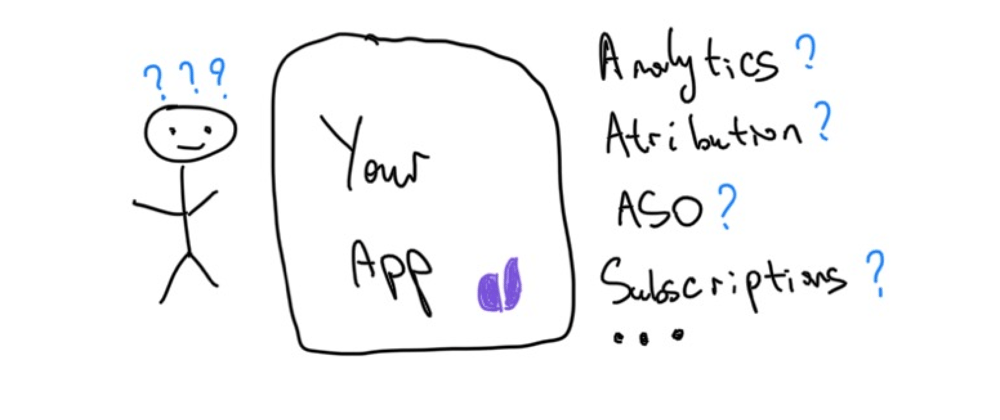Apps don’t exist in a vacuum. While there’s certainly not a great space for things a good team can’t do, some 3rd-party services could be of real help to your apps’ growth.
In this article, we will dive into valuable services for freemium iOS apps that might help any development or marketing team.
Let's draw a plan first.
An overwhelming majority of mobile apps are monetized through traffic, that is, the purchase of advertisements. I assess that most apps don’t have a website or a web version, and even platform presence is usually limited to iOS. Suppose a company doesn’t have access to a reliable organic resource (SEO, blog, etc.). In that case, the App Store Optimization (ASO) and advertisements are the only things that this company can do for a controlled promotion.
We can divide services that are useful for development and promotion into six categories:
- Traffic attribution. This will help answer where (from which ads) users come from and build the unit economy.
- Product analytics. This will help to collect user events and profiles and calculate any metric, including sales funnels.
- Sending push notifications. Optional: email.
- ASO-tools. Analytics and optimization for organic growth in the App Store.
- Crashlytics. Application crash analytics.
Let’s figure out what services are on the market, how much they cost, and how you should implement them. I will indicate only those services that I used myself or my friends did.
Attribution
Why you need it
Attribution binds users with traffic channels, determining which traffic channel—an advertising campaign or even a specific banner—brought a particular user.
Attribution has traditionally been the main component in purchasing paid traffic. Since most of the ads for apps are purchased from Facebook, you need a service to attribute this traffic. Unfortunately, there are few such services, and they are quite expensive. The reason is simple: it’s challenging to become a Facebook Marketing Partner.
Whom to choose?
Several prominent players in the market know-how to attribute Facebook: AppsFlyer (responsible for 70% of the market), Adjust, Tenjin, and Branch.
How much?
Almost every player hides the price tags, but empirically you can find out that everyone is pretty equal to AppsFlyer, and the average price will be 6 cents for the attribution of paid traffic. That is, if the service for a specific user gives you non-organic attribution, then you have to pay for it. Usually, organic traffic doesn't contribute to the cost.
In general, this price is unholy concerning the provided utility; therefore, the service’s cost will grow more slowly with the growth of volumes. Moreover, you will be obliged to pay even if the traffic is not converted and does not pay off, so you pay for the installation itself. This cost can quickly increase your cost per install (CPI) by 10%.
The conclusion is simple: bargain if you want to save money.
It's easy to calculate approximately how much AppsFlyer will cost. Let's say you buy $10,000 worth of traffic per month at an installation cost of $2 with 5,000 attributions -> 5,000 * 0.06 = $300.
Note that if you don't receive attribution data when access to IDFA is disabled, you won't pay for attribution. I officially asked AppsFlyer about this, here's the answer:
“Yes, if the client has LAT enabled, we don’t receive IDFA/GAID, and the installation can convert to organic. But we will also try to do attribution through probabilistic modeling. And if that doesn’t work out, then it will go into organic production”.
Product analytics
Why you need it
Product analytics is the ability to study what your users are doing in an application analytically. Simply put, it answers the question "What features are more users using?". Answers may vary, including cohort analysis and segmentation.
Any analytics system consists of two parts:
- Data storage. This is where raw events about user actions are stored.
- BI or data visualization, building reports on top of raw data. This is what the user is working with.
Whom to choose
Unlike attribution, where there is no alternative to 3rd-party services, you can use open source solutions and create in-house solutions in product analytics.
Stack is traditionally created on a relational columnar database, for example, Clickhouse + Tableau for BI. Additionally, I recommend using Cube.js to collect data. As words for googling, I throw in: AWS Lambda, Redash, Google Big Query, Serverless.
In general, your own solution is an excellent way to go, but it is challenging to make it work, even with all its seeming simplicity. You will always want something extra. It will take development and support time while achieving good performance is also not a trivial task. The worst thing is that you can miss the error in the data and draw the wrong conclusions. In short, if you can assemble a data team, then this should be your option.
Amplitude and Mixpanel are prominent players in 3rd-party solutions. App Metrica and Firebase Analytics (Google Analytics for mobile devices) can be added here.
Usually, multiple analysts are selected to compare their accuracy, often taking free and paid ones.
The development and implementation of any analytics system starts with drawing up a map/list of events you want to track. After two weeks of hard work on the event table, you get something like this:
Which is later added to the application and tested.
How much?
It’s difficult to calculate the cost of your implementation. For the assessment, take the work of three people over a period of 4-6 months.
Let's estimate for services:
- App Metrica and Firebase Analytics are free.
- Amplitude: Free for up to 10M events per month.
- Mixpanel: Free for up to 100K unique users per month.
I know many companies do the following: first, they track everything, and when it gets expensive, they remove unnecessary events, leaving a bare minimum.
All analytics services make money on large companies, which is why they give such large free limits.
In my experience, usually, a paid plan starts at $2,000 per month.
Sending push notifications
Why do you need it
There are two purposes for sending push notifications:
- Product. For example, you received a notification that your taxi is waiting.
- Marketing. When you are trying to sell something to a user.
Moreover, push notifications can be divided by:
- Triggered and caused manually
- Targeted and not targeted.
Most of the product pushes are triggered, that is, when a trigger occurs due to user actions, then all events in product analytics are taken from the table above in product analytics.
Marketing push notifications can be triggered—for example, a user has unsubscribed, and we immediately give him a discount. They can also be manual: for example, we will send a notification to all our London users about a discount on products in an offline store.
Whom to choose
Just like analytics, there is an option to make your own solution or use ready-to-go services. Both work through APNS (Apple Push Notifications Service).
Like many things in the Apple ecosystem for developers, working directly with APNS isn’t exactly easy and convenient. There are both technical tasks (push queue, sending speed, etc.) and purely product ones: you will have to match the user and his push token yourself.
The usual scheme is to use a provider to send push notifications and access them from your server through a convenient SDK/API. Examples of such services are AWS SNS and Firebase Cloud Messaging. FCM has a common Android system and shipping and delivery analytics, which is a nice addition.
The best system for sending push notifications allows you to build mailing campaigns, where you specify push chains, triggers, send delays, audiences, etc. These are complex and not cheap systems such as Intercom, Push Woosh, OneSignal. They support not only push notifications, but also email, in-app messages, and much more.
How much?
- Firebase Cloud Messaging is free.
- AWS SNS: 1M free, then $0.5 per million.
- OneSignal: as many messages as you want, but 10K subscribers.
The price is growing quickly and strangely, so if you have 100K or more MAU, I’d be preparing for a price tag of $1,000 per month.
ASO
Why do you need it
ASO (App Store Optimization) is an analog of SEO, only for applications. That is when a user searches for something in a search in the App Store or Google Play. With ASO you can:
- Track keyword rankings
- Track competitors
- Upgrade ranking, including localization
And other related tasks.
There are Apple guidelines for better ranking. Overall, ASO and SEO are similar things that need to be worked on all the time. You can find other guides and recommendations, they are publicly available.
Whom to choose
I’m not an expert in ASO, but I heard good reviews about AppFollow and AsoDesk. Alternatively, you can write a self-written solution: there are many libraries on GitHub that will help with this, for example, here.
How much?
Service price tags don’t vary much, I would aim for a few hundred dollars a month for a small application.
Application crash analytics
Why do you need it
Crash analytics helps you understand the reasons behind your app crashing—that is, it stopped working and the user was thrown out of it. In fact, this is the basic functionality that almost all developers use.
Whom to choose
Firebase is the de facto industry standard.
Choose whatever suits you.
How much?
Free.
Where Adapty fits in?
There is a sixth component your app would need: handling of payments and subscriptions. These things are tough to implement, especially when you want to export your data to 3rd-party attribution and analytics services.
Creating such systems on your own will take up to 6 months of work for a team of four. We don't think you need to do any of that, as Adapty will do it for you instead. Try Adapty for free with a 14-days trial.w












Top comments (1)
Thanks for the mention of OneSignal! One small correction -- OneSignal is free for an unlimited number of mobile subscribers. The 10k limit is only for web push subscribers. Of course, our paid plan also includes a lot of attractive features that are not included in the free version.